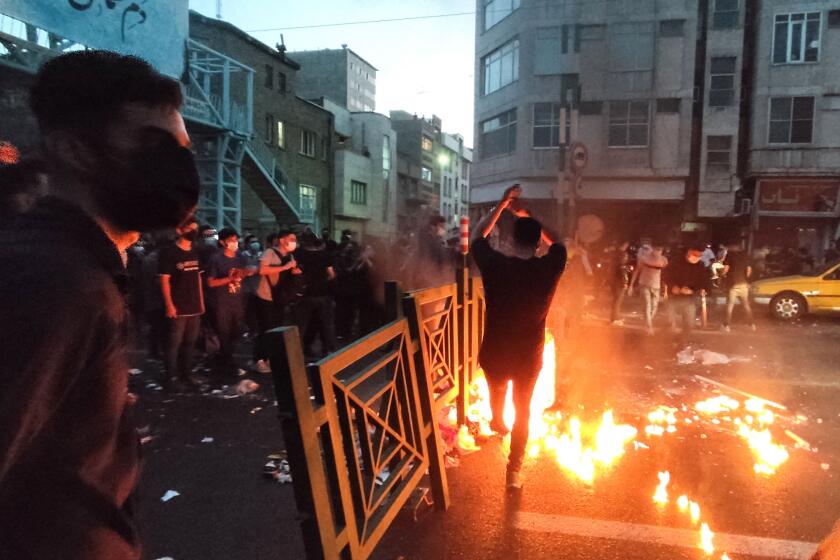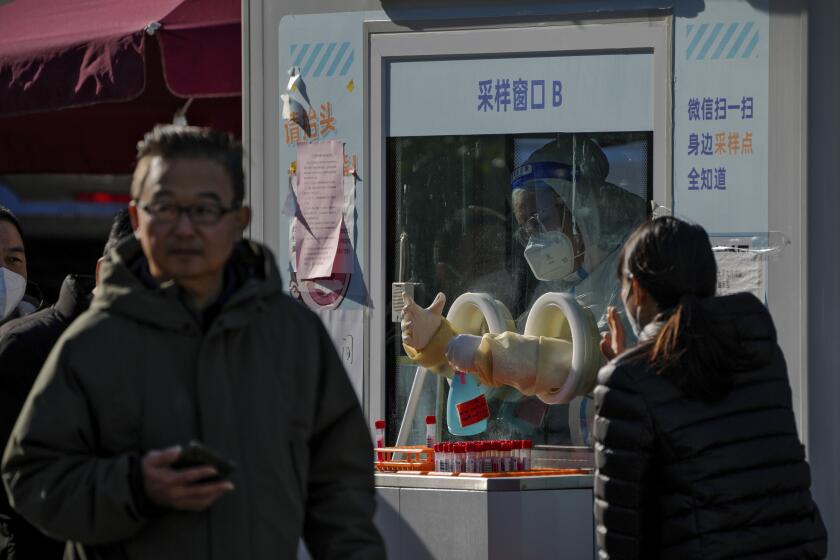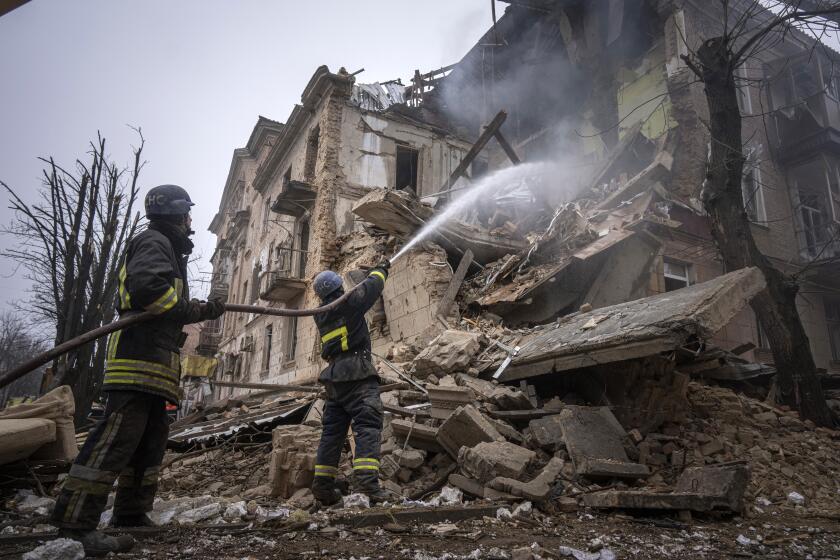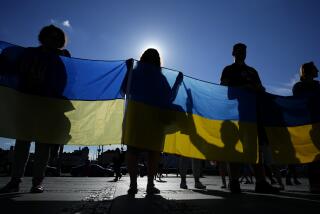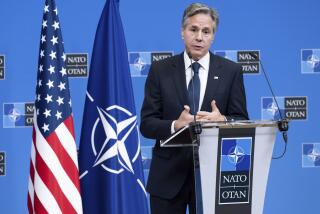Editorial: Protests in Iran and China, and defense of Ukraine, exemplify human yearning for liberty
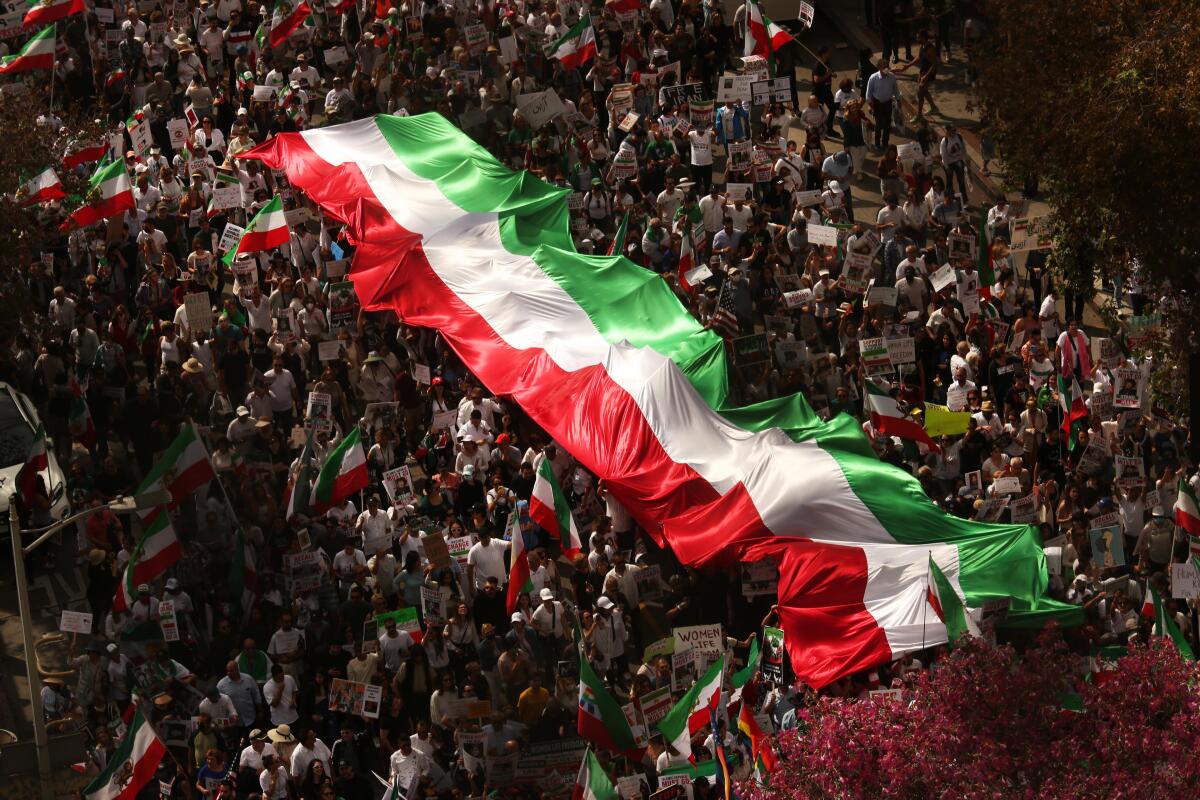
- Share via
The human spirit yearns for freedom and rebels against a regrettably human penchant for asserting dominion over others. The COVID-19 pandemic and efforts to stem the spread of disease fed a streak of authoritarian nationalism in some nations such as Hungary and Brazil — so it’s a welcome surprise to hear of protests against repressive governments in Iran and China, and to witness the armed resistance against Russian invaders in Ukraine.
The astonishing movement in Iran followed the Sept. 16 death in custody of Mahsa Amini, a 22-year-old Kurdish woman arrested by the nation’s vice squad (the “Guidance Patrol”) during a visit with family in Tehran because her hijab, or headscarf, did not completely conceal her hair. Authorities said that she was to be released after a “reeducation” session but that she died of a heart attack. Witnesses say she was severely beaten and died as a result.
Women gathered outside the hospital where Amini died, and others — men as well as women — assembled in her hometown in Iran’s Kurdistan province and in universities and cities around the nation. Protesters burned headscarves, cut their hair and chanted anti-government slogans including “Death to the dictator,” meaning Supreme Leader Ali Khamenei.
The hijab that has become a symbol of repression in Iran was once a sign of defiance against the U.S., which intervened against Iranian democracy in the 1950s and allied with the shah and his hated secret police.
Government forces attempted to shut down the recent protests with a show of force that has so far resulted in close to 500 deaths and thousands of arrests. Iranian officials reportedly handed down death sentences to participants, and at least two people have been publicly executed. But protests have spread. Supporters in other nations, including but not limited to the Iranian diaspora, have demonstrated their solidarity with Iranian woman by publicly cutting their hair.
Iranian protesters forming alliances across the political spectrum could signal a new vision for the country.
Demonstrations against the repressive Islamic government are not new. The so-called Bloody November protests against fuel price increases in 2019 threatened the government and nourished an Iranian democracy movement that had been building for several years. Anger against the government intensified after the Islamic Revolutionary Guard Corps of Iran shot down a Ukraine International Airlines plane shortly after it took off from the airport in Tehran. Street protests were briefly tamped down by the pandemic but then resumed.
It’s noteworthy that the most serious challenge yet to the repressive government comes from women who demand the right to make for themselves the most basic of choices — what clothes to put on and how to wear them — and whether to show their hair or wear makeup, actions that are prohibited by Iranian law.
Protests in China are a response to the repressive “zero-COVID” policy implemented soon after the pandemic began in early 2020. The restrictions reached what some argue was a tipping point with a Shanghai lockdown in April this year, and protests accelerated over the autumn months among people who were confined to their homes or in other places. Those who were not subject to lockdowns but were dealing with the economic fallout of repression also took part in the demonstrations. As in Iran, deprivation of personal liberty led to appeals to overthrow the government and institute democracy — a stunning move in a nation in which dissent can be severely punished, and in which social media and physical movements are closely monitored.
Defiance of the government escalated after a deadly fire in a high-rise apartment building in Xinjiang blamed on the lockdown, which blocked firefighters from quickly accessing the building.
The protests moved the government to back down, at least a bit, from its oppressive zero-COVID policies. It’s not yet clear whether that’s a mostly symbolic move, as with Iran’s asserted disbanding of its morality police, or a more sweeping concession.
A day after China announced the removal of some stringent COVID restrictions, many people are waiting to see how the new approach will be implemented.
The demand for freedom has taken a different form in Ukraine, where citizens have rallied behind the government of President Volodymyr Zelensky in defending against Russia’s efforts to crush Ukraine’s nationhood, take Ukrainian territory and destroy its cities and infrastructure. Russian leader Vladimir Putin predicted that his “special military operation” would conclude within weeks of the invasion of Ukraine that began Feb. 24. But 10 months later, despite the demolition of several Ukrainian cities, Russian forces have made little headway.
Those in Iran, China and Ukraine who have stood up to repression have earned the admiration of people all over the world, including Americans, who look for ways to help. But the fight for freedom often involves sacrifice that can be borne only in small part, if at all, by outsiders.
In Ukraine, assistance is simple, yet hazardous. The U.S. government has backed Zelensky with weapons and other assistance, and his visit to Congress on Wednesday was an acknowledgment that, courageous as the Ukrainian people are, they cannot stop Russian aggression by themselves. But U.S. aid to a fellow democracy, proper as it is, potentially pits the planet’s two greatest nuclear powers against each other. Putin recently doubled down on his nuclear threat.
The U.S. role is subject to even greater limits in China and Iran. There was little this nation could do to directly support Hong Kong protesters in 2019 in the face of Beijing’s crackdowns without risking a direct confrontation with China, which is also a nuclear power. Analysts who study Hong Kong and Ukraine have pondered what precedent they might set for an attempt by Beijing to invade Taiwan.
Simply stopping new sales of technology and equipment to Russia without shutting off existing phones and operating systems is wholly insufficient.
The nuclear threat also colors the U.S. response to repression in Iran, which may be on the verge of becoming a nuclear power. Washington can speak up for Iranian women, but its diplomatic focus is on nuclear weapons. The U.S. led the United Nations in removing Iran from the Commission on the Status of Women — an obvious and important symbolic move — but individual supporters have few options. Recall that repression of women is even more severe in Afghanistan, where the Taliban government returned to power with the U.S. exit last year, and has now banned women from universities. We have seen the limits of an American military role.
Demands for freedom and democracy in Iran, China, Afghanistan and even Ukraine are universally grounded in the human aspiration for freedom. There are times and places to directly assist, as in Ukraine, and times and places where there is little outsiders can do besides show support, cut their hair, march, chant and stand and cheer for oppressed people and their right to alter their governments.
More to Read
A cure for the common opinion
Get thought-provoking perspectives with our weekly newsletter.
You may occasionally receive promotional content from the Los Angeles Times.
